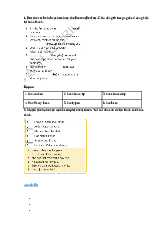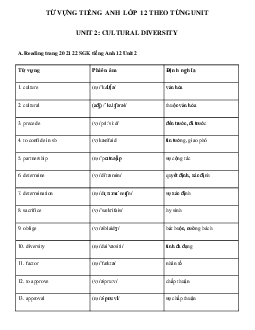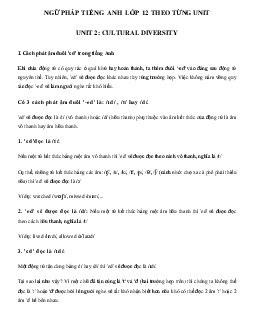





Preview text:
GIẢI SGK TIẾNG ANH LỚP 12 THEO TỪNG UNIT
UNIT 2: CULTURAL DIVERISTY
I. Reading - Unit 2 lớp 12 trang 20 21 22 SGK tiếng Anh 12 Before you read
Work in pairs. Discuss the question: Which of the follow ing fa ctors is the most
important for a happy life? Why?
love - money - parents'approval
a nice house / flat - a good job - good health
A. Which of the above factors is the most important for a happy life?
B. In my opinion, love, good health and a good job are the most important For a happy life. A. Why?
B. As we know, love, especially the true love, is an essential factor for a marriage life. Someone
compares love with light or water to life. Indeed, with love we can suffer the hardship, sufferings or
misfortunes of life. And there's an important aspect of love: forgiveness. We can say love and
forgiveness arc two inseparable qualities.
A. What about good health? Is it also indispensable too?
B. Sure. Imagine! Can you work or live a happy life if you are in ill health? A. Absolutely no.
B. And a good job can provide you with money enough for your life and your family, because money is a means (if comfort.
A. OK. I quite agree with you. While You Read
Read the text and do the tasks that follow. (Đ ọc bài đọc và làm những bài tập kèm theo)
Theo truyền thống người Mĩ và người Á châu có những ý tưởng rất khác nhau về tình yêu và hôn
nhân. Người Mĩ tin ở hôn nhân "lãng mạn"- một chàng trai và một cô gái cảm thấy thích nhau, yêu
nhau và quyết định cưới nhau. Trái lại, người Á châu tin ở hôn nhân "có tính giao ước"- cha mẹ của
cô dâu và của chú rể quyết định việc hôn nhân; và tình yêu - nếu có phát triển - được nghĩ là sự tiếp
nối hôn nhân, chứ không có trước nó.
Để chứng tỏ những sự khác biệt một cuộc khảo sát được tiến hành giữa các sinh viên Mĩ, Trung
Quốc và Ấn để quyết định thái độ của họ đối với tình yêu và hôn nhân. Sau đấy là bản tóm tắt các
câu hỏi của mỗi nhóm cho bốn ý tưởng quan trọng.
Nét hấp dẫn thể chất: Sinh viên Mĩ quan tâm nhiều về nét hấp dẫn thể chất hơn sinh viên Ấn và
Trung Quốc khi họ chọn vợ hay chồng. Họ cũng đồng ý rằng người vợ nên giữ vẻ đẹp và ngoại hình của mình sau hôn nhân.
Chia sẻ: Ít sinh viên Á châu đồng ý quan điểm của sinh viên Mĩ vợ và chồng nên chia sẻ mọi ý nghĩ
với nhau. Thực vậy, đa số sinh viên Ân và Trung Quốc thực sự nghĩ rằng không thảo luận một số
vấn đề, chia sẻ một số ý tưởng nào đó là tốt và khôn ngoan hơn. Đặc biệt rất nhiều người Ấn đồng ý
rằng giãi bày tâm sự với vợ là không khôn ngoan.
Mối tương quan của người ngang hàng: Đa số sinh viên Á châu bác bỏ quan điểm của người Mĩ hôn
nhân là mối tương quan giữa những người ngang hàng với nhau, không đòi hỏi ít hay nhiều hơn ở
nhau. Đa số sinh viên Ân đồng ý rằng trong hôn nhân đàn bà phải hi sinh nhiều hơn đàn ông.
Tín nhiệm xây dựng trên tình yêu: Đáng chú ý, nhiều sinh viên châu Á hơn sinh viên Mĩ đồng ý
rằng người chồng bắt buộc nói cho vợ nơi anh ta đã đi nếu anh về nhà muộn. Người vợ Á châu có
thể yêu cầu báo cáo những hoạt động của chồng. Người vợ Mĩ, chẳng hạn, tin chồng mình làm điều
đúng vì anh yêu cô chứ không vì anh bắt buộc phải làm.
Sự so sánh bốn ý tưởng về tính lãng mạn cho thấy người trẻ châu Á không lãng mạn bằng người Mĩ đồng trang lứa.
Task 1: Explain the meaning of the italicized w ords / phrases in the follow in g
sentences. (Giải thích nghĩa c ủa những từ/cụm từ in nghiêng ởnhững câu sau.)
1. precede: happen or exist before 2. determine: find out
3. confide: tell someone about something very private or secret.
4. sacrifice: willingly Stop having something you want.
5. obliged: having a duty to do something.
Task 2: Answ er the follow ing questions. (Tr ả lời các câu hỏi sau.)
1. They are "trust built on love, physical attractiveness, confiding and partnership of equals."
2. The Americans are much more concerned with it than the Indians and the Chinese when choosing a wife or a husband.
3. The Indian students agree that a woman has lo sacrifice more in a marriage than a man.
4. The American wife trusts her husband to do the right thing because he loves her not because he has to.
5. The main finding of the survey is young Asians are not as romantic as their American counterparts. After You Read
Work ill groups. Discuss the question: "What are the differences betw een a
traditional, Vietnamese family and a modem Vietnamese family?"(Là việc từng
nhóm. Th ảo luận câu hỏi: "Sự khác biệt giữa gia đình Việt Nam truy ền thống và
gia đình Việt Nam hiện đại?")
A. I see the traditional Vietnamese family as well as family life is changing a lot. A modern
Vietnamese family is quite different from the traditional one.
B. Thai's right. First, in my opinion, it's the size. A traditional family was usually an extended
family, that is there are more than one generation living together under one roof.
C. But now a modern family is usually a nuclear family, consisting of only parents and their children.
D. OK. And the key fact we should mention is the number of children. A traditional family was
usually a large one, with more than three. In some families, people could find the number of
children up to ten or even more. On the contrary, a modem family, especially families in big cities,
has only one or two children at most.
A. Next, in a traditional family, the father takes all responsibilities for the family. In other words,
father works and earns money to support the whole family. The woman's tasks are confined within
the family: bearing children and doing all the housework.
B. Now in a modem family, both husband and wife have to work to support the family.
C. And what's more husband and wife should share household work together.
D. That's the interesting idea about the modern family: everyone in a family has his / her own
responsibility to do, that is he / she should take part in the maintenance or the building of the family's happiness.
A. OK. The husband and the wife must have the partnership of equals in the family: no one is
superior to the other. Both have their corresponding responsibilities for his /her own.
II. Writing - Unit 2 l ớp 12 trang 25 26 SGK ti ếng Anh 12
Task 1: You are going to w r ite about the conical leaf hat or the "nón lá", a
sy mbol of Vietnamese culture. Look at the picture below . Find the Vietnamese
equivalents for the English words. (Em đ ịnh viết về "nón lá", một biểu tượng
của văn hóa Vi ệt. Nhìn vào hình tư ợng đây Tìm t ừ tương đương ti ếng Việt cho
những từ tiếngAnh.)
1. leaf: lá; 2. rim: vành nón;
3. ribs: khung nón; 4. strap: quai nón;
Task 2: Write a passage of about 150 w ords about the conical leaf hat of
Vietnam, using the outline and information below . (Vi ết một đoạn văn khoảng
150 t ừ về "nón lá", dùng dàn bài và thông tin dư ới dây.)
A Sy mbol of the Vietnamese Culture: The Conical Leaf Hat Introduction:
- symbol of Vietnamese girls/women
- part of the spirit of the Vietnamese nation Main body: Materials
- special kind of bamboo and young/soft palm leaves Shape and size Process - conical form
- diameter: 45 - 50 cm; 25 - 30 cm high
- covering the form with leaves/sewing leaves around ribs Conclusion:
- protecting people from sun rain
- girls/women look pretty/attractive
When you come to the countryside of Vietnam, especially in Hue, you can see a lot of beautiful girls
with a palm leaf conical hat on. The conical leaf hat is said the symbol of the Vietnamese culture.
The hat is made from a special kind of bamboo and young and soft palm leaves. The ribs are shaped
into a conical form. The diametre of the hat is usually about between forty and fifty-five centimetres;
and it is about twenty-five or thirty centimetres high. The ribs are covered with palm leaves which
are tightly stithed onto the bamboo frame. Finally, the hat is usually painted with a coat of furniture - polish oil.
The palm leaf conical hat is mainly used to protect from shine or rain. Beneath the broad rim of the
hat do Vietnamese girls look more attractive and charming.
III. Language focus Unit 2 lớp 12 trang 27 28 29 SGK tiếng Anh 12 Pronunciation Listen and repeat Grammar
Exercise 1. Complete the follow ing conversations w ith the correct form of the
verbs in the box. Hoàn thành cu ộc hội thoại sau với dạng đúng của động từ trong khung. Đáp án
1. Have ... seen, saw, am going to see
2. drank, have not drunk, drank
3. has written, Did ... write, wrote
4. have been cooking, cooked, cooked
Exercise 2. Circle the letter (A, B, C or D) to complete the passage. Kh oanh tròn
chữ cái (A, B, C hoặc D) để hoàn thành đoạn văn. Đáp án:
1 - C; 2 - A; 3 - C; 4 - A; 5 - C; 6 - A; 7 - C; 8 - A;
Exercise 3. Complete the follow ing letter w ith the correct form of the verbs in
brackets. Hoàn thành lá thư sau với dạng đúng của các động từ trong ngoặc.
1 - moved; 2 - moved; 3 - have asked; 4 - have not stopped;
5 - study; 6 - will fail; 7 - could talk;



